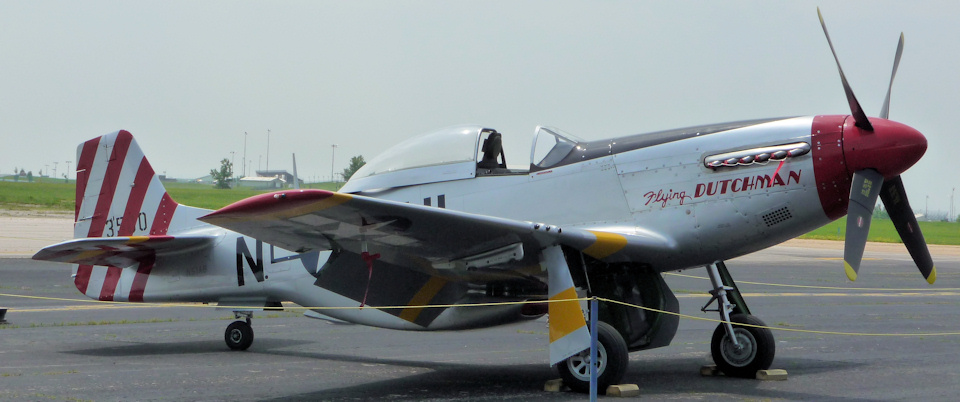Steve Craig, of Lawrence, Kansas, is the owner and operator of this beautifully restored North American P-51D (CAC-18 Mk.21 - 100th Commonwealth Aircraft of Australia-built P-51) Mustang that is available for airshows, flybys and film throughout the USA.
The P-51 was originally designed and built by North American Aviation after the British government approached them to build P-40 Warhawks under license. North American believed they could design a better fighter, and the British government gave them 120 days to prove it. 102 days after the order was placed, the first Mustang was completed, flying for the first time on October 26, 1940.
The prototype and subsequent P-51A utilized the Allison V-1710 liquid cooled engine. Lacking an effective engine supercharger, the Allison provided insufficient power for the high-altitude environment the P-51 was designed to operate in. By replacing the Allison engine with a Rolls-Royce V-1650 Merlin engine that had a two-stage supercharger, the necessary power and performance was gained. The Merlin engine, which was built in the U.S. under license by the Packard Motor Car Company, was installed in all further P-51 models from the “B” through the “H” versions.
The P-51 was the United States supreme air-superiority fighter in the European Theatre of Operations (ETO) during WWII. It served as a fighter-interceptor, Bomber-escort and fighter-bomber. With the powerful Merlin engine and droppable fuel tanks, the Mustang was able to penetrate deep into German territory where no previous Allied fighter had been able to go. The P-51 could escort bombers to all but the deepest targets inside Germany. With a fighter escort, fewer bombers were lost to the Luftwaffe’s fighters. Reichmarschall Hermann Goering, Supreme Commander of the Luftwaffe said “ When I saw Mustangs over Berlin. I knew the war was lost.
The P-51 was considered by many to be the finest fighter that the U.S. produced and flew in WWII accounted for almost half the enemy aircraft destroyed in Europe by U.S. fighters. The Mustang was equipped with six .50 caliber machine guns and incorporated the advanced K-14 lead computing gun sight. The unmistakable scoop on the underside of the Mustang is the air inlet for the coolant radiator and oil cooler.
During WWII, the Royal Australian Air Force (RAAF) operated RAF Mustangs and in 1945 received their first shipment of 215 D model and 84 K model RAAF P-51s. Commonwealth Aircraft of Australia also built 200 P-51s under license from NAA.
The Mustang was used by RAAF pilots in Korea until April 1951. A combined total of over 15,500 Mustangs were produced. The greatest number of Mustangs were built as the “D” model, with over 8,000 built. Today less than 150 Mustangs remain flyable or restorable to flying condition.
Steve's beautifully restored P-51D Mustang is in the markings of Bob Goebel's "Flying Dutchman" of the 31st Fighter Group. In September 1944, Bob Goebel made his last Mustang flight having accumulated 303 hours of combat flying in 61 missions. He shot down 11 enemy aircraft and was awarded the Silver Star, the Distinguished Flying Cross with one Oak Leaf Cluster and the Air Medal with 17 Oak Leaf Clusters. He had recently been promoted to the rank of captain at the ripe old age of 21. Bob returned to the U.S. before the war ended, and in 1948, he earned a Bachelor of Science Degree in physics. He also kept his hand on the fighter stick serving as Commander of the 126th Fighter Squadron in the Wisconsin Air National Guard; he flew the P-51D Mustang and the Lockheed F-80 Shooting Star.
In 1950, Bob returned to active duty and served with the Atomic Energy Commission. He was assigned to the Gemini Launch Vehicle Directorate for which he oversaw 12 Titan II vehicles as they were being reconfigured into booster rockets for the Gemini space program. Bob retired from the Air Force in 1966 with the rank of Lieutenant Colonel. Retirement did not prevent Bob from aiming for the stars: while employed at McDonnell-Douglas, he worked on the Skylab program. He eventually retired for good and moved with his family to California, and in 1991, he wrote a book about his combat flying career titled "Mustang Ace; Memoirs of a P-51 pilot.
Commentary above courtesy of Warbird Depot
This aircraft is on temporary display at the Combat Air Museum
| TECHNICAL
NOTES: |
|
Manufacturer: |
Commonwealth Aircraft of Australia |
Model: |
CA-18 Mk.21 |
Basic Role: |
Single seated WWII fighter |
Crew: |
Pilot |
Engines: |
Rolls-Royce Merlin V-1650-7 |
Maximum Speed: |
505 mph (813 kph) |
Cruising Speed: |
395 mph ( 636 km/hr) |
Max. Range: |
1,160 mi (1,865 km) with external tanks
|
Service Ceiling: |
41,600 ft (12,700 m) |
Wingspan: |
37 ft 0 in (11.28 m) |
|
|
|
|
|
|
|
|
|
9,500 lbs (4,310kg); Max Take-off 11,500 lb
(5,215 kg) |
|
(Various models) 10 zero rail; rockets under wings; six .50-caliber machine guns; bomb racks for up to 1,000 pounds of stores or extra fuel tanks under the wings |
|
US Army P-51-5-NA Serial # AAF 44-13500 (FAA Reg. Number N51AB) |





